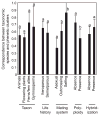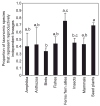The nature of plant species
- PMID: 16554818
- PMCID: PMC2443815
- DOI: 10.1038/nature04402
The nature of plant species
Abstract
Many botanists doubt the existence of plant species, viewing them as arbitrary constructs of the human mind, as opposed to discrete, objective entities that represent reproductively independent lineages or 'units of evolution'. However, the discreteness of plant species and their correspondence with reproductive communities have not been tested quantitatively, allowing zoologists to argue that botanists have been overly influenced by a few 'botanical horror stories', such as dandelions, blackberries and oaks. Here we analyse phenetic and/or crossing relationships in over 400 genera of plants and animals. We show that although discrete phenotypic clusters exist in most genera (> 80%), the correspondence of taxonomic species to these clusters is poor (< 60%) and no different between plants and animals. Lack of congruence is caused by polyploidy, asexual reproduction and over-differentiation by taxonomists, but not by contemporary hybridization. Nonetheless, crossability data indicate that 70% of taxonomic species and 75% of phenotypic clusters in plants correspond to reproductively independent lineages (as measured by postmating isolation), and thus represent biologically real entities. Contrary to conventional wisdom, plant species are more likely than animal species to represent reproductively independent lineages.
Figures


References
-
- Levin DA. The nature of plant species. Science. 1979;204:381–384. - PubMed
-
- Raven PH. In: Modern Aspects of Species. Iwatsuki K, Raven PH, Bock WJ, editors. Univ of Tokyo Press; Tokyo: 1986. pp. 11–29.
-
- Hickman JC. The Jepson Manual of Higher Plants in California. Univ of California Press; Berkeley: 1993.
-
- Bachmann K. Species as units of diversity: an outdated concept. Theory Biosci. 1998;117:213–230.
-
- Mishler BD. In: Species: New Interdisciplinary Essays. Wilson RA, editor. MIT Press; Cambridge, Massachusetts: 1999. pp. 307–316.
Publication types
MeSH terms
Grants and funding
LinkOut - more resources
Full Text Sources
Other Literature Sources

